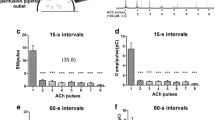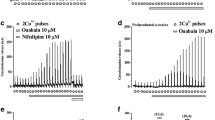Abstract
The role of protein phosphorylation in catecholamine secretion from bovine adrenomedullary chromaffin cells was studied using different protein kinase inhibitors. Naphthalenesulfonamide derivatives as ML9 and ML7, more specific for the myosin light chain kinase, and the calmodulin antagonist W7 inhibited catecholamine secretion 20 and 40% respectively in digitonin-permeabilized chromaffin cells. ML9 also decreased calcium evoked protein phosphorylation of different proteins including tyrosine hydroxylase in permeabilized cells. These naphthalenesulfonamide derivatives showed also an effect in intact cells, ML9 and W7 produced 50% inhibition in catecholamine secretion and45Ca2+ uptake, however H8 had no effect. The partial [3H]nitrendipine binding displacement of these drugs to adrenomedullary membranes suggests that these sulfonamide derivatives could interact directly with L-type calcium channels in intact cells. The results obtained in permeabilized cells suggest a possible role of protein phosphorylation in the regulation of catecholamine secretion in chromaffin cells.
Similar content being viewed by others
Abbreviations
- ML9:
-
1-(5-Chloronaphthalene-1-sulfonyl)1H-hexahydro-1,4-diazepine hydrochloride
- ML7:
-
1-(5-Iodonaphthalene-1-sulfonyl)-1H-hexahydro-1,4 diazepine hydrochloride
- H7:
-
1-(5-isoquinolinesulfonyl)-2-methylpiperazine dihydrochloride
- H8:
-
N-[2-(methylamino)ethyl]-5-isoquinolinesulfonamide dihydrochloride
- W7:
-
N-(6-aminohexyl)-5-chloro-1-naphthalenesulfonamide hydrochloride
- PKI:
-
protein kinase A inhibitor
- HEPES:
-
N-(2-hydroxyethylpiperazine-N′-(2 ethanesulfonic acid)
- PIPES:
-
piperazine-N, N′-bis (2-ethanesulfonic acid)
- EGTA:
-
[ethylene-bis (oxyethylenenitrilo)] tetraacetic acid
- SDS:
-
sodium dodecyl sulphate
- PAGE:
-
polyacrylamide gel electrophoresis
- DMEM:
-
Dulbecco's Modified Eagle's medium
- MLC:
-
myosin light chain
- MLCK:
-
myosin light chain kinase
- TH:
-
tyrosine hydroxylase
References
Holz, R. W., Rothwell, C. E., and Ueda, T. 1980. Cholinergic agonist stimulated phosphorylation of two-specific proteins in bovine chromaffin cells: correlation with catecholamine secretion (Abstr.) Soc. Neurosci. Abstr. 6:177.
Amy, C. M., and Kirshner, N. 1981. Phosphorylation of adrenal medulla cell proteins in conjunction with stimulation of catecholamine secretion. J. Neurochem. 36:847–854.
Côté, A., Doucet, J.-P., and Trifaró, J.-M. 1986. Phosphorylation and dephosphorylation of chromaffin cell proteins in response to stimulation. Neurosci. 19:629–645.
Gutierrez, L. M., Ballesta, J. J., Hidalgo, M. J., Gandia, L., Garcia, A. G., and Reig, J. A. 1988. A two-dimensional electrophoresis study of phosphorylation and dephosphorylation in response to secretory stimulus of chromaffin cell proteins. J. Neurochem. 51:1023–1030.
Lee, S. A., and Holz, R. W. 1986. Protein phosphorylation and secretion on digitonin-permeabilized adrenal chromaffin cells. Effects of micromolar Ca2+, phorbol esters and diacylglycerol. J. Biol. Chem. 261:17089–17098.
Gutierrez, L. M., Hidalgo, M. J., Palmero, M., Ballesta, J. J., Reig, J. A., Garcia, A. G., and Viniegra, S. 1989. Phosphorylation of myosin light chain from adrenomedullary chromaffin cells in culture. Biochem. J. 264:589–596.
Kanda, K., Sobue, K., and Kakiuchi, K. 1985. Phosphorylation of myosin light chain and the actin-activated ATPase activity of adrenal medullary myosin. J. Biochem. 97:961–964.
Saitoh, M., Naka, M., and Hidaka, H. 1986. The modulatory role of myosin light chain phosphorylation in human platelet activation. Biochem. Biophys. Res. Commun. 140:280–287.
Saitoh, M., Ishikawa, T., Matsushima, S., Naka, M., and Hidaka, H. 1987. Selective inhibition of catalytic activity of smooth muscle myosin light chain kinase. J. Biol. Chem. 262:7796–7801.
Nakanishi, A., Yoshizumi, M., Hamano, S., Morita, K., and Oka, M. 1989. Myosin light chain kinase inhibitor, 1-(5-chlornaphthalene-1-sulfonyl)-1H-hexahydro-1,4-diazepine (ML9), inhibits catecholamine secretion from adrenal chromaffin cells by inhibiting Ca2+ uptake into the cells. Biochem. Pharmacol. 38:2615–2619.
Almazan, G., Aunis, D., Garcia, A. G., Montiel, C., Nicolas, G. P., and Sánchez-Garcia, P. 1984. Effects of collagenase on the release of [3H]-noradrenaline from bovine cultured adrenal chromaffin cells. Br. J. Pharmacol. 81:599–610.
Dunn, L. A., and Holz, R. W. 1983. Catecholamine secretion from digitonin-treated adrenal medullary chromaffin cells. J. Biol. Chem. 258:4989–4993.
Wilson, S., and Kirshner, N. 1983. Calcium-evoked secretion from digitonin-permeabilized adrenal medullary chromaffin cells. J. Biol. Chem. 258:4994–5001.
Laemmli, U. K. 1970. Cleavage of structural proteins during the assembly of the head of bacteriophage T4. Nature. 277:680–685.
Reig, J. A., Li Yu, and Klein, D. C. 1990. Pineal transduction. J. Biol. Chem. 265:5816–5824.
Meyer, D. I., and Burger, M. M. 1979. Isolation of a protein from the plasma membrane of adrenal medulla which binds to secretory vesicles. J. Biol. Chem. 254:165–175.
Ballesta, J. J., Garcia, A. G., Gutierrez, L. M., Hidalgo, M. J., Palmero, M., Reig, J. A., and Viniegra, S. 1990. Separate [3H]nitrendipine binding sites in mitochondria and plasma membranes of bovine adrenal medulla. Br. J. Pharmacol. 101:21–26.
Bradford, M. M. 1976. A rapid and sensitive method for the quantitation of microgram quantities of protein utilizing the principles of protein-dye binding. Anal. Biochem. 72:248–254.
Hidaka, H., Inagaki, M., Kawamoto, S., and Sasaki, Y. 1984. Isoquinoline sulfonamides, novel and potent inhibitors of cyclic nucleotide dependent protein kinase and protein kinase C. Biochem. 23:5036–5041.
Niggli, V., Knight, D. E., Baker, P. F., Vigny, A., and Henry, J.-P. 1984. Tyrosine hydroxylase in “Leaky” adrenal medullary cells: Evidence for in situ phosphorylation by separate Ca2+ and cyclic AMP-dependent systems. J. Neurochem. 43:646–658.
Nagatsu, T., Suzuki, H., Kiuchi, K., Saitoh, M., and Hidaka, H. 1987. Effects of MLCK inhibition on catecholamine secretion from rat pheochromocytome PC12 cells. Biochem. Biophys. Res. Commun. 143:1045–1048.
Ehlert, F. J., Itoga, E., Roeske, W. R., and Yamamura, H. I. 1982. The interaction of [3H]nitrendipine with receptors for calcium antagonists in the cerebral cortex and heart of rats. Biochem. Biophys. Res. Commun. 104:937–943.
Hennessey, T. M., and Kung, C. 1984. An anti-calmodulin drug, W-7, inhibits the voltage-dependent calcium current in Paramecium Caudatum. J. Exp. Biol. 110:169–181.
Tachikawa, E., Takahashi, S., Kashimoto, T., and Kondo, Y. 1990. Role of Ca2+/phospholipid-dependent protein kinase in catecholamine secretion from bovine adrenal medullary chromaffin cells. Biochem. Pharmacol. 40:1505–1513.
Author information
Authors and Affiliations
Rights and permissions
About this article
Cite this article
Reig, J.A., Viniegra, S., Ballesta, J.J. et al. Naphthalenesulfonamide derivatives ML9 and W7 inhibit catecholamine secretion in intact and permeabilized chromaffin cells. Neurochem Res 18, 317–323 (1993). https://doi.org/10.1007/BF00969089
Accepted:
Issue Date:
DOI: https://doi.org/10.1007/BF00969089




